 thinkCSC has partnered with Anchor, combining thinkCSC’s powerful hosting and managed services with Anchor’s sync, sharing and collaboration platform to give partners unprecedented collaboration on a secure, locally hosted network. SyncedTool provides a distinctive and secure way for you to do business. Implementing SyncedTool will allow businesses to eliminate the need for VPNs and FTPs, which can represent a significant cost savings.
thinkCSC has partnered with Anchor, combining thinkCSC’s powerful hosting and managed services with Anchor’s sync, sharing and collaboration platform to give partners unprecedented collaboration on a secure, locally hosted network. SyncedTool provides a distinctive and secure way for you to do business. Implementing SyncedTool will allow businesses to eliminate the need for VPNs and FTPs, which can represent a significant cost savings.
SyncedTool is a true business solution.
Dropbox vs. SyncedTool: Collaboration
SyncedTool gives employees the ability to collaborate on documents, as files can be opened and revised simultaneously from multiple sites. It is a powerful and secure collaboration tool. Dropbox will recognize only one version of a file; therefore, there are no shared files, and employees working on identical files run the risk of overwriting one another’s versions.
Dropbox vs. SyncedTool: File Access
Many companies have moved their files to the cloud or are giving serious thought to making the transition to a cloud-based collaboration solution. Whereas in the past most companies have relied on local file servers to store and revise documents, this method has proven over time to be inefficient. Yet another drawback presented by local file servers is that, while users can access a file server via a virtual private network (VPN) or using file transfer protocol (FTP), there is no offline access. This prevents mobile access and forces users to email themselves files, which presents both a security risk and a risk that the most current version of the document is not available to the entire team. Furthermore, users provided with access to the file server may also have access to your system. Utilizing local file servers is not only inefficient; it is an insecure way of doing business.
Dropbox vs. SyncedTool: Security
SyncedTool can be scaled to the number of users who are required to work internally. If you have 50 internal employees and only 15 need to work offline, then you only need to have 15 users added to the service. Employees and guest users can be added as needed; however, you maintain control over what documents may be accessed by each user. When employees leave your company, access may be restricted as necessary. With SyncedTool, you can remove employee accounts from the system and remotely wipe file access from computers and handheld devices.
Google Drive and Dropbox provide ways to improve file access and efficiency, but they do not provide network security, nor do they allow users to work on the same file simultaneously. With these solutions, a stranger hosts your data, and everyone uses the same encryption key. There is no way to track employee data usage or document access, and there is no revision history.
Dropbox vs. SyncedTool: Secure Hosting
External hosting also means that your information will be stored on a remote, third-party server, without the benefit of local administration. And should the remote server go down, your documents go with it. There is no integration with your business environment or applications. Ultimately, these external hosting services control your data (deleting revisions and files without your consent) and provide no true means of backing up or restoring your files. These hosting services are consumer solutions, not business solutions.
One of the primary benefits of SyncedTool is that if you do have an issue, you can call thinkCSC. A stranger isn’t hosting your data anymore, a neighbor is. Other offsite data hosting services may be free, but in the end, you get what you pay for. SyncedTool is an investment worth considering to empower your teams for better collaboration without sacrificing security and compliance. When choosing between Dropbox and SyncedTool, there is only one choice.

Recent Comments